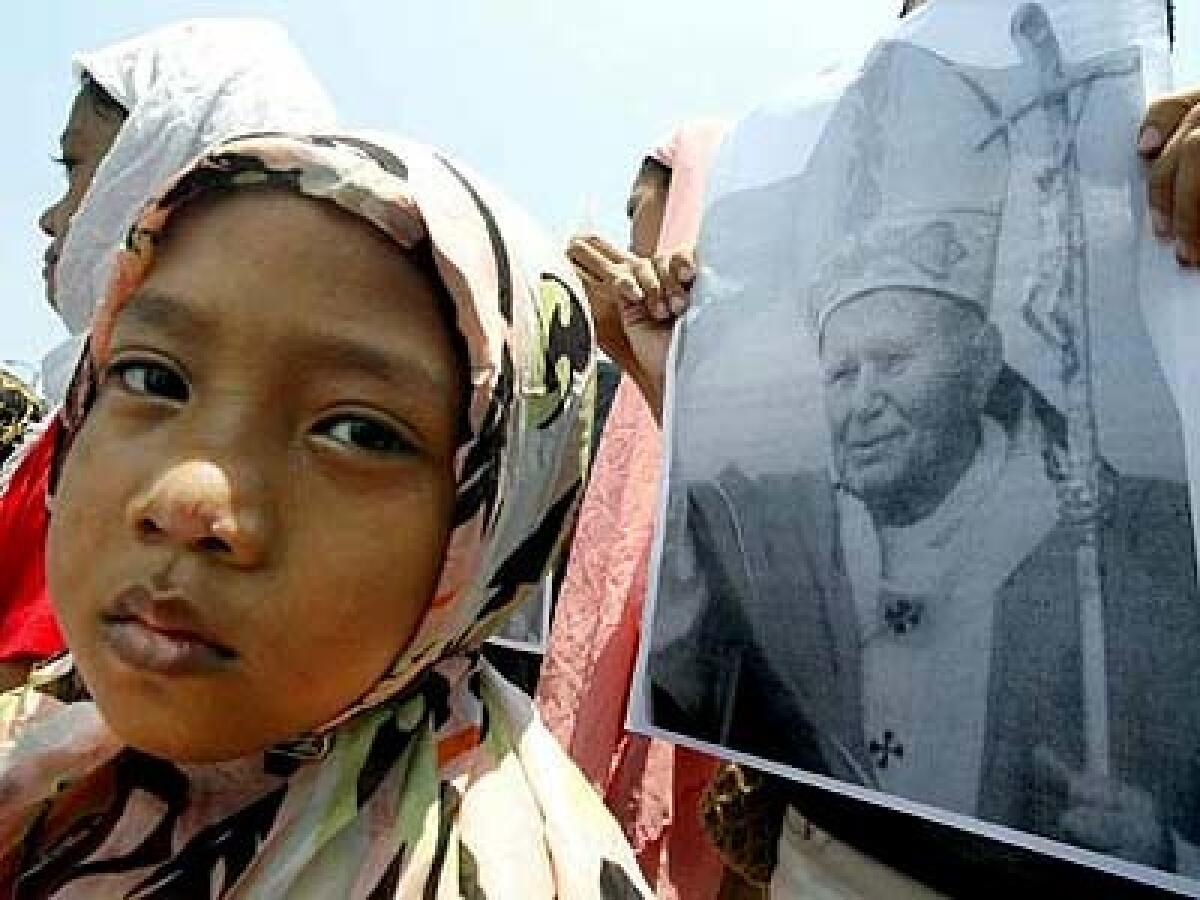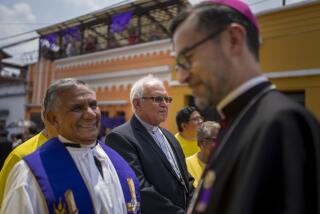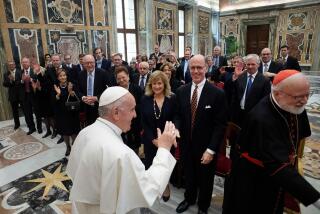Bridging Philippinesâ Islands of Faith

MANILA â Baclaran Redemptorist Church is a cavernous, seven-story structure with a vaulted ceiling and hundreds of pews. Throughout the day Wednesday, 120,000 Catholics came to worship, as they do every Wednesday. Pope John Paul II celebrated Mass here.
Across busy Roxas Boulevard is the Baclaran Grand Mosque. Despite its name, there is nothing grand about it. Unfinished after nine years, its modest onion dome presides over a squattersâ settlement of poverty and squalor. After fire swept through the community of 5,000 this week, destroying 170 shanties and killing two children in their sleep, Muslim leaders complained that they were receiving little help from the Catholic-dominated central government.
FOR THE RECORD:
Catholic population âA graphic accompanying an article in Thursdayâs Section A about Catholicism in the Philippines said Mexico had 126 million Catholics. Estimates vary, but most sources put the number of Catholics in Mexico at about 90 million.
The contrast between the church and the mosque highlights the gulf between two groups that have lived side by side in inequality for centuries. The worldâs largest Roman Catholic country with a substantial Muslim population, the Philippines is a divided nation that witnesses frequent violence between followers of the two faiths.
Now, with the death of John Paul, many Filipino Catholics and Muslims hope that his successor will continue his efforts to reach out to Muslims. Many Muslims here also hope the next pope will maintain John Paulâs strong stance against the war in Iraq, a conflict they view as an attack on their religion by the United States.
âIf the new pope is not a peace-loving man, I donât know what will happen,â said Abdelmana Tanandato, 44, a Muslim who lives in a shack next to the mosque. âI hope the new pope will be the same as John Paul II.â
The tension in the Philippines between the religions underlines a global rift that John Paul, more than any of his predecessors, worked to bridge. As Catholic cardinals prepare to convene in the Vatican next week to choose his successor, they are divided over how vigorously the next pope should pursue conciliation with Islam, which like Catholicism, boasts about 1 billion adherents.
John Paul met with Islamic leaders all over the world, preaching brotherhood and engaging in dialogue. He apologized for past misdeeds of the church, including the Crusades. In Syria in 2001, just four months before the Sept. 11 attacks, he became the first pope to enter a mosque.
But his outreach to Islam and other religions worried many in his own church who felt that he was leading it into relativism, the belief that no religion is any more authentic than another. The Vaticanâs own doctrinal office appeared to undermine his effort in 2000 with a document asserting the supremacy of Christian faith as a means to salvation.
The head of the doctrinal office and author of that document, German Cardinal Joseph Ratzinger, is a leading candidate to become the next pope. He views the relationship between Christianity and Islam as one of competition and calls for shoring up Europeâs Christian identity as the number of Muslim immigrants grows. Other cardinals, in remarks since the popeâs death April 2, have stressed the need for cooperation.
âThe history between Catholicism and Islam is not a happy one,â Cardinal Francis George of Chicago said at the Vatican last week. âWe want to live at peace in a global society, so a dialogue with Islam is particularly important.â
Catholicism, imported to the Philippines by explorer Ferdinand Magellan in 1521, swept Islam aside long ago to become the countryâs dominant religion.
Most of the nationâs 68 million Catholics and 5 million Muslims live in poverty, but Muslims are relegated to second-class status with little voice in the affairs of the government or the economy.
âOne of the richest churches here in the Philippines is the Catholic Church, and the Muslims are very poor,â said Cosain Naga, a Muslim activist who ran unsuccessfully for Congress. âBy that comparison, you can see that there is a big neglect of the Muslims. There is no equal treatment.â
In a country of 84 million people, Muslims are barely represented within the government. There are no Muslims in the presidentâs Cabinet and no Muslim members of the Senate. Just 12 of Congressâ 236 members are Muslims.
The southern Philippines, where most of the countryâs Muslims live, has become a breeding ground for Islamic extremism. Groups such as Abu Sayyaf, which has historic ties to Osama bin Laden, have carried out deadly bombings against Christian targets. The group has also kidnapped dozens of Christians in the south, beheading some and releasing others for ransom. Mainstream Muslim leaders reject Abu Sayyafâs claim to represent Islam.
In 1995, Manila police uncovered a scheme by Muslim extremists connected with Al Qaeda to assassinate John Paul during a visit here and bomb 11 airliners over the Pacific. The plan was foiled, but some of the plotters escaped detection and went on to organize the 2001 attacks on the World Trade Center and Pentagon.
The Philippine central government, with the backing of the United States, has responded to the threat by waging war against the extremists. The military has deployed 81,000 troops in the south and frequently uses its small air force to bomb Muslim areas where rebels are believed to be operating.
This week, a U.S. diplomat here warned that the southern island of Mindanao was becoming âthe new Mecca for terrorismâ and that foreign extremists were operating freely in the area. Parts of the island are so lawless, said Charge dâAffaires Joseph Mussomeli, that it runs the risk of becoming another Afghanistan.
âMany Muslims donât feel they belong to the Filipino nation because the Filipino nation is Christian,â Archbishop Orlando Quevedo of Cotabato City acknowledged in a telephone interview. âThe government and the church should bridge the gap between Muslims and Christians in ways that are imaginative to make the two groups one Filipino nation.â
Quevedo noted that the popeâs record as an advocate of peace won praise even from militant Muslim leaders, such as Mohagher Iqbal, chief information officer for the rebel Moro Islamic Liberation Front in Mindanao. The group, with at least 10,000 armed combatants, has been negotiating on and off with the government to reach a peace accord.
The pope was âa tireless campaigner of world peace and champion of religious reconciliation,â Iqbal said. âThe passing away of the pope is a great loss to the world. He is a very important figure who dedicated his life to peace and justice for all.â
The Catholic Church has long been active politically in the Philippines, backing the ouster of President Ferdinand Marcos during the âpeople powerâ revolt of 1986.
President Gloria Macapagal Arroyo caused a stir last week by saying that John Paul personally gave her his blessing in 2000 when she was vice president to oust then-President Joseph Estrada. Accused of stealing millions of dollars, Estrada remains under arrest at a military camp, and his trial has been dragging on for years.
âHe was very encouraging toward me with regard to my taking steps to make sure that I would do what I could do in order to promote morality in Philippine society,â Arroyo said in an interview on CNN.
Arroyo acknowledged that as president she had heeded church advice to oppose divorce, population-control programs, same-sex marriage and the death penalty.
Critics contend that church policies opposing family planning and the use of condoms have contributed to the countryâs widespread poverty and the spread of HIV and AIDS.
Even some Filipino priests say privately that it is time for the church to reevaluate its stand against condoms because of the need to halt the spread of the deadly sexually transmitted disease.
Church leaders, however, do not expect significant changes with the selection of a new pope, in part because John Paul appointed nearly all the cardinals who will choose his successor.
âWhoever comes in, the election of a new pope will always be an occasion for a wider discussion of areas that were not encouraged for discussion,â said Archbishop Leonardo Legaspi of Caceres. âWhether it will lead to a change, I donât know.â
Some churchmen say John Paul had a special fondness for the Philippines dating back to his first visit, in 1973 as a cardinal. He made a brief stop in Manila as he flew from Europe to Australia for a conference. At the time, the Philippines and Poland did not have diplomatic relations, and he could not legally enter the Philippines on his passport.
But immigration officials learned of his desire to say Mass at a Manila church. They allowed him to enter the country and suggested that he visit Baclaran, which is near the airport. It happened to be a Wednesday and the church was crowded with worshipers.
When he visited the Philippines for the first time as pope in 1981, he made the Baclaran church his first stop.
At the time, there were few Muslims in the neighborhood. But over the last decade, some have fled the violence in Mindanao for the district around the Baclaran church and the hope of making a living in Manila. Many have become street vendors, selling pirated DVDs and other goods.
In 1996, they began building the Baclaran Grand Mosque, which consists of a large room supported by four 25-foot columns. The building has a roof, but some of the unfinished concrete walls bristle with iron bars. Built on reclaimed land near the center of the city, the mosque gives permanence to the settlement, which might otherwise be razed by authorities seeking to use the valuable acreage for other purposes.
Some of the hovels around the mosque are made of cinderblocks; others have walls of scrap wood or plastic sheeting.
Not a single tree grows on the site, and the ground around the perimeter is littered with trash accumulated over years. There is no city sanitation system, no water supply or electricity.
Like residents of the squattersâ settlement, Muslims throughout the Philippines believe they are victims of discrimination by the Catholic-dominated government. They hope the next pope will continue trying to bring the religions together.
âI think that the pope, as the head of a big religion, can be a beacon, can make changes in treating the Muslims,â said Naga, the activist. âWe want a younger and stronger version of Pope John Paul II, so he can continue the work of the Vatican in reaching out to the Muslims for peace.â
*
(BEGIN TEXT OF INFOBOX)
Center of belief
The Philippines is one of the world centers of Roman Catholic population:
Religious composition
Catholic: 81%
Protestant: 9%
Muslim: 5%
Buddhist / other: 5%
*
Nations with most Catholics, in millions:
Brazil: 151
Mexico: 126
Philippines: 68
United States: 64
Italy: 58
*
Sources: Catholic-hierarchy.org; CIA World Fact Book, Times reporting. Graphics reporting by Tom Reinken
*
Times staff writer Richard Boudreaux in Rome contributed to this report.
More to Read
Sign up for Essential California
The most important California stories and recommendations in your inbox every morning.
You may occasionally receive promotional content from the Los Angeles Times.










